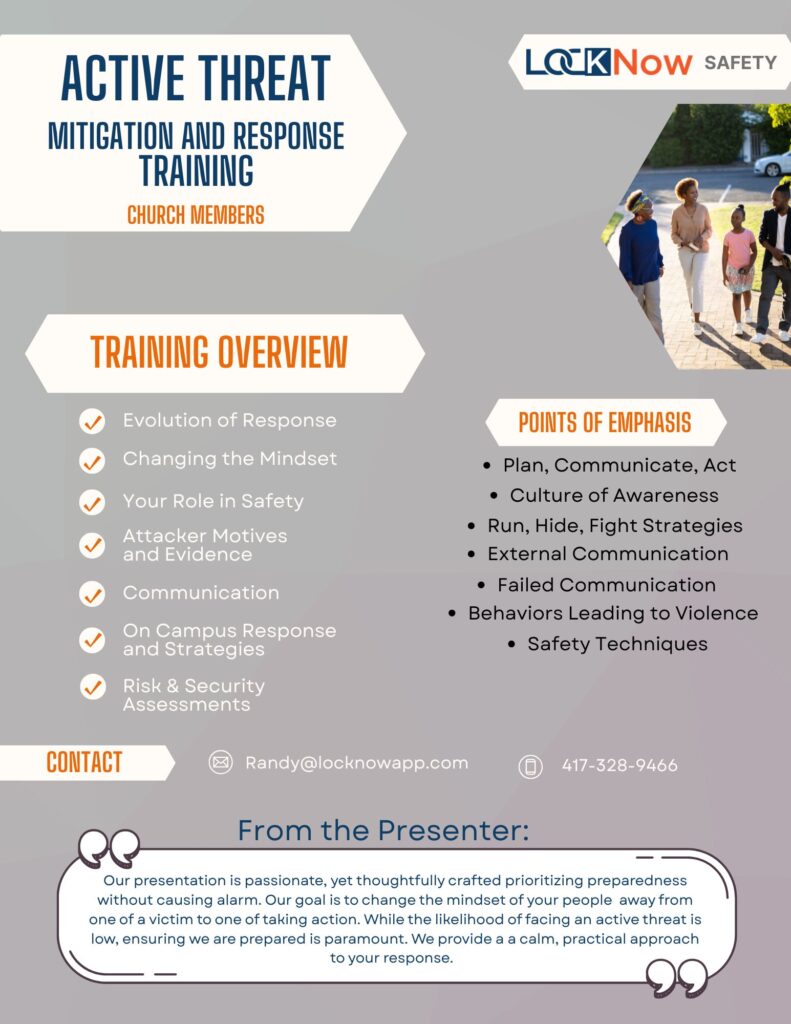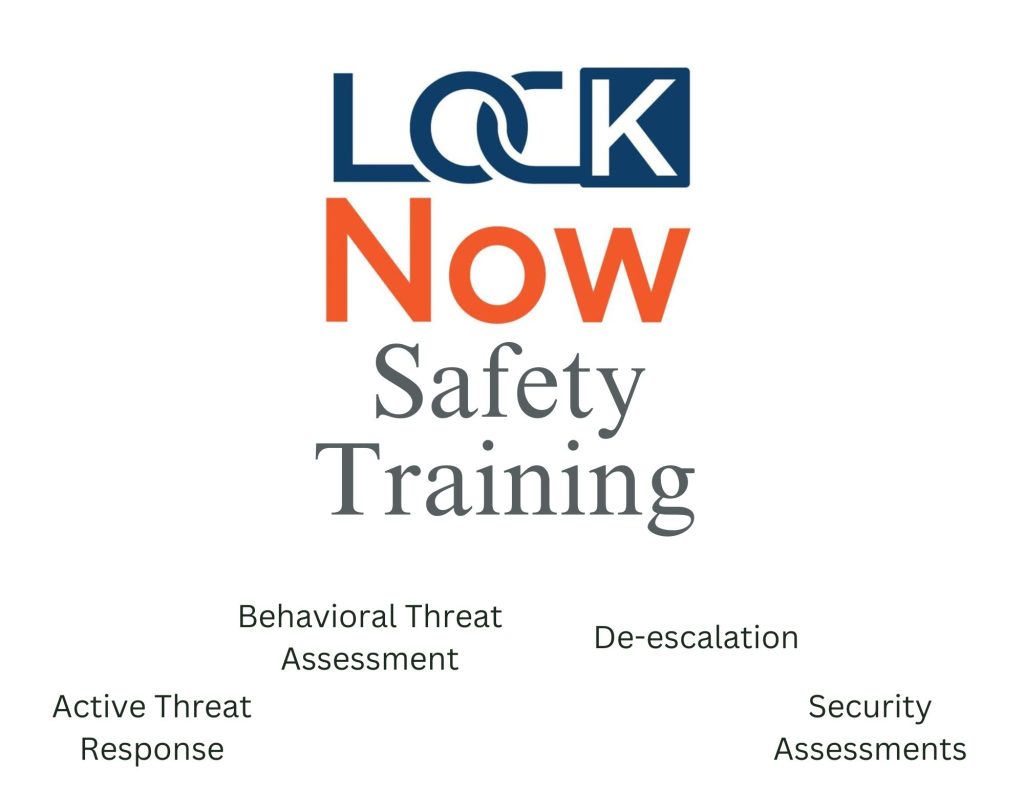
A house of worship is where people seek solace, find peace, and connect with their faith. The doors of a church are always open, welcoming people from all walks of life. However, this open-door policy also creates potential security vulnerabilities that demand careful planning and management.
According to a study by the Family Research Council, 436 acts of hostility were identified against churches in 2023 alone, more than double the previous year and eight times higher compared to 2018.
These alarming figures suggest church security is a pressing issue and rapidly escalating issue worldwide. Vandalism, harassment, and more serious threats like active shooters pose a significant risk to the safety of congregants, volunteers, and staff.
Churches need to strike a balance between being welcoming and secure for the safety of everyone who enters the door. The key to achieving this balance is building a culture of safety within the congregation.
What is a Culture of Safety?
A culture of safety refers to an environment where security is valued and ingrained in the daily operations and attitudes of the organization. In the context of churches, a culture of safety prioritizes the protection and well-being of members, visitors, and property.
The key to creating a culture of safety is understanding that security is not just the responsibility of a designated team or individual. Safety is a shared responsibility that involves everyone in the congregation, from church leaders to volunteers and members.

Key elements of a culture of safety
To make your church safe and secure, focus on 4 important things that help keep everyone protected. These include:
- Risk assessment
Identify potential risks and vulnerabilities within the church premises and develop strategies to mitigate them. Regularly audit your security planning and implementation and bring in experts to review your physical safeguards.
- Emergency planning
Develop comprehensive emergency plans to avoid unexpected high risk events like fire, medical emergencies, and active shooter incidents. Church members need to be informed about these plans and educated on how to respond efficiently. We offer comprehensive training to prepare and respond to an active threat.
- Training
Educate your team and volunteers on how to handle emergencies and maintain security, including access to control and surveillance systems within the church. Regular training helps keep everyone updated and prepared for any potential threats.
- Collaboration
Encourage a spirit of teamwork among church leaders, staff, volunteers, and members to create a united front in security efforts. A culture of safety becomes stronger when everyone commits to vigilance and communication, aiming for a common goal: safety for all.
Locknow provides a variety of safety training for churches, email us for details at team@locknowapp.com.

How to Involve Your Congregation in Church Security?
Creating a culture of safety is not a one-person job. It requires the involvement and commitment of everyone in the congregation.
Education and training
Education and training are fundamental in creating a knowledgeable and prepared congregation.
- Training sessions: Conduct regular training sessions for staff, volunteers, and members to familiarize them with emergency procedures, access control systems, and other security protocols.
- Workshops or seminars: Invite experts to conduct workshops or seminars on topics like situational awareness, self-defense techniques, and active threat response tactics. These can also serve as team-building activities for different groups within the congregation.
- Online resources: Utilize online resources such as webinars, videos, and articles to educate members on security topics, especially during times when in-person training may not be possible.
Communication and awareness
Any organization’s success lies in effective communication, and the same applies to building a safety culture.
Church services, events, and gatherings provide an excellent opportunity to communicate vital security information and promote awareness among members.
Keep the congregation informed about any security updates, protocols, and safety tips through:
- Announcements during church services or events
- Informational posters or flyers placed in common areas
- Church newsletters or bulletins
- Social media platforms or church websites
- Email updates to members
The more members are aware of security measures and potential risks, the better they will be to respond in an emergency.
Volunteer opportunities
Involving volunteers in church security efforts not only lightens the load for staff but also creates a stronger sense of community within the congregation.
To encourage volunteerism in security tasks, build a sense of ownership and purpose by explaining the benefits of their involvement.
More individuals trained in security procedures means a quicker and more organized response in an emergency. Additionally, it gives members a sense of empowerment by actively contributing to the safety of their church community.
To recruit and train volunteers for security tasks, consider the following steps:
Talk to members who have expressed interest in serving or have law enforcement, military, or security backgrounds. These individuals may have the necessary skills and experience to assist with security tasks.
Conduct thorough background checks and screenings for potential volunteers to ensure the safety of everyone in the congregation. Provide comprehensive training on security protocols and procedures to all volunteers.
The emergency response, access control systems, and communication strategies should be included in the training. Also, provide volunteers with the necessary tools and resources to carry out their tasks effectively.
Support and collaboration
Building a culture of safety requires support and collaboration among church leaders, staff, volunteers, and members. Together, they can create a stronger front against potential security threats.
To foster unity and teamwork in security efforts:
- Hold regular meetings with all parties to discuss security measures and address any concerns or suggestions.
- Encourage open communication among members and provide a safe space to discuss potential risks or vulnerabilities.
- Recognize and appreciate the contributions of individuals in security efforts, whether big or small. This helps to create a sense of purpose and motivation for continued involvement.
The sense of community and support among members can also extend to other areas, creating a more cohesive and united congregation overall.
Ongoing evaluation and improvement
Regularly evaluating and improving church security protocols is essential for maintaining an influential safety culture.
Set up a security committee or designate a team to regularly evaluate and update security protocols. The committee should include individuals with diverse backgrounds, skills, and perspectives to ensure comprehensive evaluations.
Mock emergency drills can also help identify any weaknesses in current security procedures and allow for necessary improvements.
Encourage members to provide feedback and suggestions on security measures, as they may have valuable insights from their experiences.
Remember, building a solid security culture is an ongoing process that requires continuous evaluation and improvement. With the involvement and support of all members, your church can create a safe and secure environment for all.
How to Implement a Church Security Plan?
For church security, preparation is key. A comprehensive plan can help prevent and mitigate potential threats or emergencies. Here are 5 steps to consider when implementing a church security plan:
Risk assessment
The first step in creating a security plan is to conduct a thorough risk assessment. This involves identifying potential threats and vulnerabilities specific to your church’s location, size, and demographics. A risk assessment helps inform the components of your security plan, such as emergency response procedures and access control systems.
If you are unsure how to conduct a risk assessment, resources are available online, or consider hiring security professionals for assistance.
Communication plan
On top of having a solid security plan, clear communication is vital in ensuring the safety of everyone involved. A designated emergency communication plan should be established and regularly reviewed with all staff members and volunteers.
The critical factors to consider when creating a communication plan include:
- Methods of communication (e.g., phone, email, text message)
- Emergency contact information for congregation members and staff
- Designated emergency response team members and their roles
- Instructions for contacting and communicating with emergency responders
- A system for updating and informing members of any changes to the plan
Emergency response plan
Having a detailed and well-rehearsed emergency response plan will help minimize chaos in a security threat or emergency.
The plan should include specific protocols for emergencies, such as natural disasters, medical emergencies, or active shooter situations. The evacuation routes and designated safe areas within the church building should also be clearly outlined.
More extensive security measures, such as surveillance cameras or panic buttons, may be necessary for larger churches or those in high-risk areas. For churches with limited resources, seeking guidance from local law enforcement or other security professionals helps create an effective plan for your specific situation.
Training and drills
Preparedness for any potential emergency helps minimize panic and confusion during an actual crisis. The key to preparedness is regular training and conducting drills.
Training sessions should cover topics such as recognizing and responding to potential threats, identifying emergency exits and safe areas, and proper communication protocols. Drills should be conducted at least twice yearly, with designated leaders and congregation members participating.
The more familiar everyone is with the church security plan and procedures, the better equipped they will be in an emergency.
Continual improvement
As threats and risks evolve, so should our church security measures. Regularly reviewing and updating the security plan is a way to ensure continued effectiveness.
Consider setting up a security committee or designating a team to regularly evaluate and improve church security protocols. Encourage feedback and suggestions from all members, as they may have valuable insights based on their experiences.
Training and Building the Skills of Volunteers
Engaging congregation members as volunteers in church security efforts requires proper training and skill-building. The key areas to focus on when building the skills of volunteers for church security are:
Church-specific skills
The specific skills needed for church security volunteers may vary depending on your church’s size, location, and potential risks.
In any emergency, knowing how to administer first aid or perform CPR can make all the difference. Consider organizing first aid and CPR training sessions for interested volunteers to equip them with life-saving skills.
Volunteers should be familiar with the layout of the church building and know emergency escape routes. They should also be trained to identify potential security threats and how to respond appropriately.
Equipment and technology
In addition to skills training, volunteers should also be trained in properly using security equipment and technology. This could include:
- Security cameras
- Alarms and access control systems
- Two-way radios or communication devices
- SAAS (Security as a Service) software like “Lock Now APP”
Be sure to provide clear instructions and guidelines for using these tools, as well as regular maintenance and checks to ensure they are in working order.
Professional training and assistance
The assistance of professional security consultants or organizations can be invaluable in building a comprehensive and effective church security plan. These professionals can provide training, conduct risk assessments, and offer advice on specific measures to take based on your church’s unique needs.
Research and reach out to reputable organizations or consultants specializing in church security. They can provide valuable insights and resources for building the skills and knowledge of your volunteers.
Conclusion
Continual training, skill-building, and seeking professional assistance when needed will help ensure a strong and capable team of volunteers for your church’s security efforts. Remember, investing in the safety of your congregation is always worth it.
As the saying goes, “An ounce of prevention is worth a pound of cure.” So let’s work together to keep our churches safe and secure. Learn more about Locknow Safety Church Training here.
